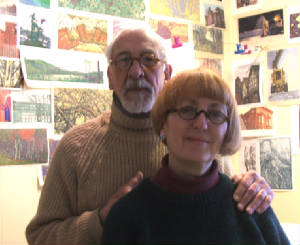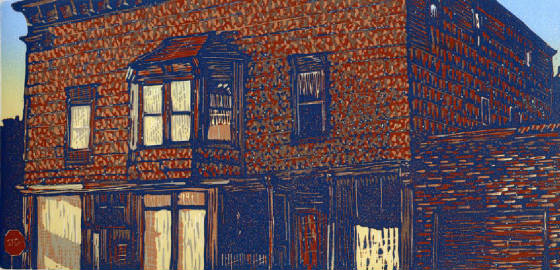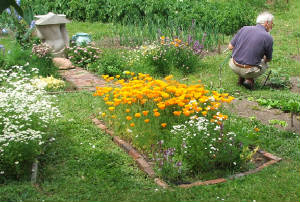|
|
 |
|

|
| Tom Rudd and Margo McCafferty |
Tom Rudd and Margo McCafferty
make art in a small town called Calumet on the Keweenaw Peninsula in Northern Michigan. A sculptor and a painter respectively,
Tom and Margo create work informed by their wooded surroundings and the omnipresent environmental crisis, with frequent reference
to water.
Along with their individual works, the two artists have
found collaboration rewarding. They work together to create color reduction relief prints.
Each year, for more than decade, Tom and Margo have completed
a series of prints, each series depicting an environment or happening in places where they have lived or were artists-in-residence,
ranging from the Cascade Mountains of Oregon, the Allegheny Mountains of Pennsylvania, Isle Royale National Park, Pictured
Rocks National Lakeshore and the Midwest’s Rustbelt. They are presently working on an ongoing series reflecting the
landscapes of the Keweenaw Peninsula.

|
| 6th Street Stop, print by Margo McCafferty and Tom Rudd |
|
 |
Zinta
for The Smoking Poet: Welcome to our spring issue, Tom and Margo! Indeed, you’ve brought spring with you, adding
vibrant color and life to our pages. In our previous issue, we featured the work of other Keweenaw Peninsula artists, poets and writers for those who would like to learn more about
this fantastically beautiful peninsula off a peninsula, that being Michigan’s Upper Peninsula. The two of you, two artists
married in person and passion, live on the Keweenaw Peninsula in a village called Calumet.
You are not Calumet natives, however. Tell us the
story of how you came to the Keweenaw and why—and how living there affects your art.
Margo:
I grew up in Salem, Oregon. Tom spent his childhood in Meadville, Pennsylvania, and eventually joined the Coast Guard.
He first came to this area when he was stationed on an icebreaker in Lake Superior. Later, when he was facilitator for services
for individual artists at the Michigan Council for the Arts in Detroit, and later with the Michigan Commission on Public Art,
Tom’s work would sometimes lead him back up to the U.P.
When we lived in Oregon, we would still visit the
Keweenaw occasionally, attracted by the edge-of-the-known–world atmosphere here that is strangely compelling.
In 2005, while we were living in Pennsylvania, we
were very fortunate to be selected as artists-in-residence at Isle Royale National Park. We spent almost 3 weeks in the artists’
cabin on Scoville Point, and by the time we left the Island, we were convinced that we wanted to live in the U.P. full time,
winters and all. We spent a few days exploring the Keweenaw, and realized that it had everything we were looking for: peace,
beauty, clean air, affordable housing, a wonderful artistic community and marvelously interesting and creative people.
The biggest influence on our art has to be the presence
of the lake. It is so enormous. Even when we don’t see it, I think on some level we are always aware of it.
TSP:
You are two artists with two distinctly different styles, using different mediums. Please speak each to your own art and
how you’ve come to that form, how it has evolved over time.
Tom: Like most visual artists, I think that I was born with a distinct curiosity for
all things visual. My curiosity for the visual elements of life soon centered
itself around the three-dimensional which I have been firmly involved with for the past many decades.
Margo:
I grew up in western Oregon, and have always been enamored with the subdued
colors of rocks, waves, tree bark and overcast skies. Part of the attraction, for me, of the Keweenaw is its wonderful range
of subtle, earthy colors.
I’ve experimented a lot with dry pigments, oil and acrylics
over the years, and painted a lot of trees, birds and insects. But the first medium I learned to use was watercolor, and I
still love it. Right now I am working in egg tempera. The subject matter is different (rooftops), but the colors are very
similar to those in my other works.

|
| Tom in the Calumet garden |
TSP:
Other times, you have worked on projects together. For many artists, that is probably hard to imagine—art can be such
a personal statement. Yet artist studios over history have also been filled with collaborations. What kind of projects do
you choose (or choose you) for collaborative efforts? How does that work for you? How do you resolve differing opinions on
artistic direction? And do you end the day with a smile?
Tom: When Margo and I first joined forces we searched for a way that we could combine
our areas of visual knowledge. I was flabbergasted by Margo’s expertise regarding color and 2D design. Prior to starting
our color reduction relief prints we experimented with some other mediums. We dabbled in single color woodcuts, Polaroid color
transfers, serigraphy and some intaglio processes. I don’t know how many different collaborative art ventures we have
tried. Not all have been aesthetically successful, but all of them have influenced our development as artists.
We eventually began collaborating on color reduction
relief prints, which are multiple-color woodblock prints that use only one block rather than a block for each color. We’ve
been making these since the mid ‘90’s. Each time we begin a print, we decide upon an image and come up with a
composition that will fit on the block. Margo makes a list of colors—she usually wants to use eleven or twelve colors,
I would prefer five, so we compromise with eight or nine. Margo mixes the colors, and I carve the block and print each color.

Margo:
Our first collaboration was actually in grant writing, when we were both employed at the Oregon Arts Commission. We worked
so well together, and our backgrounds, influences, thoughts and goals were so similar. So we got married. Our grant was funded,
too.
Actually, after four years of living in Calumet,
we still often smile whenever we consider how happy we are to be here, together.
TSP:
You’ve lived in other places, too, and have stated that you do a different series wherever you live as a combined project.
Tell us about some of those combinations of places and art—and what series you’ve done where you live now, or
are planning as a future project.
Margo:
Wow, there are a lot of these. I think one of our favorites was a series of prints based on a big flood we witnessed while
we were living in the Santiam River canyon in the Cascade Mountains in Oregon in the mid-nineties. We made lots of images
of houses swept away by torrents of water.
Tom: We
are influenced by everything around us, and our artwork is a reflection of that. Over the last four years, images of the lake,
the sky over the lake, bird wings, fish, boats, mineshafts and Calumet buildings have shown up in our work. Right now we are
making a print of a non-existent cold climate insect that lives in the ice. We’re
not sure if this is a start of a new series, but it might be …
TSP:
Do you ever address philosophies or political or spiritual issues in your work? For instance, you’ve done an environmental
series about the Keweenaw to bring to light some of your ecological concerns. Do you find art is naturally a vehicle for expressing
one’s views/concerns? Does it ever adulterate it?
Margo:
Tom and I are very concerned with the plight of the environment, and certainly it has informed our work in certain ways. Tom did an installation at Daybreak Star Art Center in Seattle a few years ago, entitled
“Where Dirt Comes From,” which addressed the issue of the importance of protecting the forest’s soil; this
was a response to the depletion of natural resources due to over-logging resulting in mudslides and other habitat destruction.
Tom: However, for both of us, aesthetic
concerns supersede all other issues in our respective and joint artworks; we try always to make that our primary concern.
TSP:
You’ve both been artists-in-residence in various places (Isle Royale, Pictured Rocks). Tell us about these experiences.
Why are such residencies important? Not only to the artist, but to the locale …
Tom:
Our residencies with the National Park Service have provided us with time away from the usual interruptions of everyday
life, giving us a chance to truly renew our artistic energies, as well as to gather visual information for new work. Spending
two or three weeks away from telephones, computers and T.V., immersed in the beauty of Pictured Rocks and of Isle Royale changed
us for the better, in that it enriched and helped to mature our sense of aesthetics.
Hopefully the fact that these residencies
link the parks with the arts reinforces the notion that the land is much more than a “natural resource” (that
term always makes us cringe) to be exploited for material gain.
TSP:
You both teach art workshops. How does teaching art add to your experience of being an artist? Or is it simply a more practical
extension of being an artist?
Margo:
The old saying that the teacher always learns more than the students is true. Teaching forces us to clarify our own thoughts
about art, regarding both technique and aesthetics. And we always learn a great deal from our interactions with students and
other teachers. We were fortunate to have spent a week as artists-in-residence at Toledo School for the Arts, and being in
that environment with so many people so passionate about art was quite invigorating.
TSP:
Tom, you carve and sculpt stone. That has to be a tremendous process already in the first phases of choosing your materials
before you ever even get started shaping it. And surely not a very forgiving one, either. Tell us more about your stone work
…
Tom: Over the past several decades I have gone through as many processes for selecting
and working materials as works produced. I select pieces of stone for quality and aesthetics, then stash them till an idea
evolves. Right now I have lots of material hanging around, including several pieces of red marble hiding under six feet of
snow. Maybe I should make a couple maquettes, start the process so when the snow melts I can work on a small piece or two. You’re
right, much of my stone sculpture is designed for outdoor installation, and therefore I take pains in selecting stone that
will endure and provide color, texture and volume that complement the proposed site. I also have to consider other factors,
such as workability and logistics, but it’s all part of the process that I have learned and taught.
TSP:
And Margo, you work in a variety of media. When you get an idea, how do you choose
your medium of expression?
Margo:
It is sometimes hard to decide which medium to use, since there are so many to choose from. I often want something gritty
and earthy looking, so I use oil over dry pigments adhered with acrylics to a rigid support. I also like the spontaneous but
controlled look of watercolors. I’m using egg tempera at the moment because I like the ethereal glow of that medium.
I’ve been planning a very limited edition artists’ book…and would love to make animations … I need
more hours in the day.
TSP:
I understand you also have children who enjoy the arts. And you home school? Describe the role of art in your curriculum …
Tom
and Margo: Our daughter, Ursula Vernon, resisted the call to make art for a while, but finally could no longer ignore
her genetic makeup. She now is a North Carolina artist, illustrator and writer,
most recently of the “Dragonbreath” series of children’s books, published by Penguin.
Our son Max is homeschooled, and has always been
interested in making art and in writing. Two years ago, thanks to the generosity of Ed Gray of Miskwabik Press here in Calumet,
he was given the opportunity to edit a book called “Keweenaw: Art from our Youth.” Like his sister and his parents,
Max spends a part of each day on creative writing and the visual arts. He can also play the piano, which mystifies the rest
of us, since we have no musical abilities whatsoever.
We hope that his exposure to the arts on a daily
basis will establish a habit of creative thinking that will be useful to him in whatever discipline he decides to pursue later
on in his life.
TSP:
Where can our readers learn more about and see more of your work?
Tom
and Margo: We show our work at the Vertin Gallery and Gallerie Boheme, both in Calumet, at the Copper Country Community Arts Center in Hancock, the Michigamee Moonshine Gallery
in Michigamee, and Flatlanders Art Galleries in Blissfield. One of Tom’s
large fish sculptures can be seen in Fish Park, a tiny park in Corktown in Detroit. Our works, both individual and collaborative,
are represented in many private and public collections.
We have a new website where
you can see some of our work online, at http://mccaffertyrudd.com/
and Margo has a blog at http://circuitousroute.wordpress.com/
TSP: Thank you, both, for sharing your selves with The
Smoking Poet in such beautiful fashion. We are honored.
Thank you!
To learn more about Margo and Tom, see: Keweenaw Now
|
 |
|
|
 |
|
|
 |
|
|
|
|
ŠAll materials, print, artwork and photography on this site are copyrighted and
not to be reprinted without written permission by The Smoking Poet.
Feedback, submissions, ideas? Email thesmokingpoet@gmail.com
|
|
|
 |

